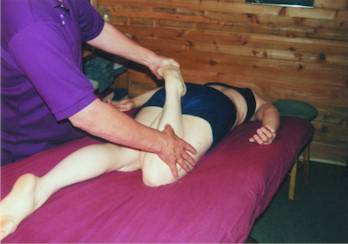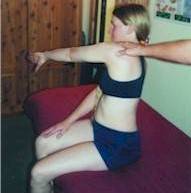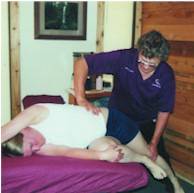Positive Health Online
Your Country

Treating Chronic Pain Deep Tissue vs. Muscle Release Technique
listed in bodywork, originally published in issue 52 - May 2000
In anatomy class, we all learned that when there is trauma or injury to a muscle, the result is adhesions and scar tissue in the fibres of the muscle. This results in a shortened, tight muscle. In massage school, we were taught specific deep tissue techniques to help break up these adhesions and scar tissue in order to give our clients relief from their pain. I am no exception. After I graduated from massage school and got a little experience under my belt, I felt as though I was doing some very good work. I quickly gained the reputation of being able to do deep tissue work. Most of the clients I worked with, who were in pain, loved the fact that I was so strong. At least I could help them with their chronic pain. But the client would return again and again with the same chronic problem. Even with the very limited knowledge I had at that time, I was very proud of the work I was doing.
Releasing the Trapezius muscle

Releasing the Tibialis Anterior
My business continued to blossom. It felt good to be able to help the clients who came to me with chronic pain problems, even if it was only on a temporary basis. What more could a new massage therapist ask for? I never dreamed that one day I would become the victim of a repetitive use injury like so many therapists in the field. However, after several years of doing deep tissue work on a daily basis, the inevitable happened. I developed tendonitis on my right medial epicondyle. Did it hurt? Yes, but this 'big macho male' thought it would go away in a few days. After all, with me, pain has always gone away in a few days. I began to have pain in other areas of my body as well. I thought to myself, "for God's sake, I am helping other people so I can't get hurt. I have found my purpose in life. These people need me!"
The Healer Becomes the Victim
I continued to do deep tissue work. I thought the tendonitis would disappear as quickly as it started. At that point in my life I really didn't understand what tendonitis really was. I received weekly massages, as instructed in massage school. The massage therapist I was seeing at that time didn't know any more about how to treat my tendonitis problem than I did. Finally I went to my family doctor for help. He told me to take over-the-counter anti-inflammatory drugs. Those drugs did nothing to bring me relief. His next step was to send me to physical therapy. The physical therapist told me the muscles in my arms were weak and I needed to strengthen them. I thought, "How can I use a muscle every day, doing massage therapy, and the muscle needs strengthening?" However, I did exactly what the physical therapist said, and as a result, my tendonitis got worse. I have since learned one cannot strengthen a short tight muscle because you are not dealing with a healthy muscle. Strengthening only compounded my problem. The strengthening made the muscle even shorter and tighter, so the tendonitis continued to worsen. My doctor then referred me to an orthopaedic surgeon. This doctor put me on prescription anti-inflammatory drugs. These drugs seemed to help with the pain but I know now that the drugs were only treating the symptoms of my tendonitis problem by masking the pain I was experiencing. As Jim and Phil Wharton state in the Wharton's Strength Book "Pain is Mother Nature's loud, clear signal that your body is being damaged and that you need to stop whatever you're doing." I took the drugs for fourteen months and my tendonitis continued to worsen. The surgeon suggested surgery; however I refused. Since I was in so much pain myself, I considered finding another career. I knew I couldn't continue on this path. The healer had become the victim. The culprit was the deep tissue work.

Releasing the Infraspinatus muscle

Releasing the Quadratus Lumborum
The Problems with Tight Muscles
Several years ago I was fortunate enough to learn a technique that I choose to call the Muscle Release Technique.™ I learned that the real cause of tendonitis is a muscle becoming too tight, or short, from repetitive use. After a period of time, the muscle begins to pull some of the fibres off from their attachment sites. A short tight muscle will restrict circulation, which causes inflammation. This constant overuse of the muscle causes memory loss in the muscle itself. In other words, the muscle loses its memory to go back to a relaxed, elongated state. I learned that the deep tissue work I had been doing only breaks up adhesions and scar tissue. It does nothing to lengthen the muscle, or to relieve the pulling of the muscle at the attachment site. Deep tissue work also does nothing to restore the muscle memory and increase circulation.
After learning this muscle work, I was able to treat my tendonitis problem myself. It has been over five years since I experienced my acute tendonitis problems. My tendonitis disappeared and has not returned. I was very impressed with how this work helped me. After experiencing relief myself, I was eager to help my clients suffering from chronic pain problems. I started using this very simple technique on my clients and the results have been remarkable. The deep tissue work I had done in the past only broke up scar tissue and gave the client temporary relief. The client would return within a couple of weeks with the same chronic problems. This is due to the fact that the scar tissue reformed in the muscle and the deep tissue work did nothing to restore the muscle memory. By using the Muscle Release Technique,™ we not only break up scar tissue, we lengthen the muscle. This results in more flexibility, no more nerve impingement and no more pain. By using this technique regularly, the muscle memory is restored and most pain sufferers experience permanent relief. Some of the most exciting and important benefits of this work include its effectiveness and the fact that it is so much easier on the therapist. The deep tissue work takes a toll on the therapist over time.
The Crucial Importance of Flexibility
I have learned many things through this ordeal. The one thing that I consider most important is that flexibility is the key to most chronic pain problems. I read the following in The Whartons' Stretch Book by Jim and Phil Wharton, "If muscles are flexible around a joint, I could be injured. I should be tight to perform better, right? Wrong!" They go on to say, "There is a big difference between a strong muscle and a tight one. A tight muscle can be very weak and offer virtually no protection for a joint. A tight muscle is an inefficient muscle. It's prone to injury because you can't move it fast enough or position yourself well enough to avoid trauma or the effects of overuse. It tracks rigidly and has a limited range of movement. Power is the combination of strength and flexibility." Another item mentioned in this book hit me right between the eyes, "to avoid hammer toes, chronic low back pain, tennis elbow, tendonitis, osteoarthritis, carpal tunnel syndrome, scoliosis, plantar fasciitis, bunions and Achilles tendon contracture, concentrate your flexibility work on applicable Active-Isolated stretches."
If flexibility is the cure for all these afflictions, then a lack of flexibility must be the cause. Is it possible that this could be true? You bet it is! However, if you have some of these afflictions, it takes more than just simple stretching to break up the adhesions and scar tissue that have formed. That is where the Muscle Release Technique™ is so effective, profoundly effective.
Since I learned this work, my business has not just increased, it has exploded. I am booked several months in advance and have at least 30-40 people on a waiting list at any given time. I am not working nearly as hard as I was before I learned this technique. Every massage therapist who is hurting, or is not satisfied with the results they are getting in their practice, should learn the Muscle Release Technique.™ Does it sound too good to be true? Just try it! For me, seeing is believing.
What Is The Muscle Release Technique?™
The Muscle Release Technique™ (MRT) is a unique injury therapy that combines compression, extension, movement and breath to give the therapist a tool to provide, in many cases, relief from pain in one treatment. With MRT™ scar tissue is broken up, the muscle is lengthened, muscle memory is restored and relief from pain starts immediately. MRT™ can be performed on just about any muscle in the body. Simply by putting a little pressure on the muscle tissue, and at the same time putting the muscle through a specific plane of stretch, holding only for two seconds, the muscle memory is being restored. Circulation is also restored and inflammation is decreased. Any time we can increase circulation to an inflamed area, healing will be promoted. Any therapist with an open mind and a desire to learn can learn this very simple technique. It will change your life and the lives of the clients who depend on you. Isn't that what it's all about? I know that I want to make a difference. What about you?
Comments:
-
SACHIN said..
upper back and shoulder pain
-
Rob Bechard said..
Encouraging circulation lightly but frequently works well, only blood (oxygen and nutrients) heal and allow for improved flexibility. Regular encouragement is like having a toothbrush for muscles, if we depended on a gum massager practitioner to maintain our gums we would mostly have sore gums. Try googling a toothbrush for muscle. And for upper back and shoulder pain you will find non compliant Triceps. One of the purposes of the Long Head is to stabilize the shoulder joint, a stable shoulder joint relieves upper back and shoulder pain.
